5. Maneuvering of FRC
Clearing the Ship’s Side
When a boat is lowered from the Davits the painter should be secured as far forward as practical not impeding other survival craft. If a stern line is used it should be checked away as boat is lowered.
The ship should be moving at a speed no greater than 5 knots with the wind and swell on opposite side of the launch and when the FRB touches the water the following should take place:
- Release the falls from hook
- With the drive engaged forward Increase RPM to give some slack in the painter.
- While staying alongside, “Release the painter”.
- Increase rudder angle to slew off 10˚-20˚. If boat is stuck alongside through the ships suction, move RPMs back and forth to form a water wedge between the ship and the boat.
- When boat is off the ship’s hull, start increasing power away from the ship.
Important: Do not cross the ship’s bow wave!
5.1 Maneuvering at Slow Speed
When maneuvering at slow speed reaction time is slower but damage is less likely. Marinas and certain harbours have a low wake restriction in place to protect their property. It is important to listen on VHF channel 16 for broadcasts such as diving operations taking place so that your wake doesn’t interfere with their operations. All engines should be at the operating temperatures before full power can be used.
Pivot Points
The Pivot points for boats vary due to the construction and drive systems. Most vessels are forward of amidships. The pivot point moves fore and aft depending on whether the boat is going ahead or astern and speed. This should be known for maneuvering, docking, and retrieving someone from the water.
External Forces
Wind, current and sea state affect the vessels handling. When approaching a heavy sea state use power to get bow pointed into it and reducing power at the top of the crest is essential to prevent broaching. Always use the wind to assist you in docking. Running down a sea with the wind behind you, your vessel should stay at the same speed as the wave.
5.2 Manoeuvring at Fast Speed
FRB’s are designed to be driven at high safe rates of speed, the coxswain should know the vessels characteristics. The boat itself is operated with one hand on the wheel and the other on the throttle. When manoeuvring to come along side someone in the water with a jet boat, one hand on the wheel and one on the bucket control.
5.3 Boat handling in adverse weather
Always approach seas head on or nearly head on, and reduce power when at the top, so as not to cause the craft to get airborne at top of crest.
A-is the correct approach
B- can cause the vessel to turn violently when over the crest
C- vessel is broached and can possibly capsize.
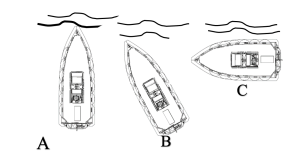
5.4 Towing
Communications
As of any operation, communications should be set up between the tow vessel and the stricken vessel. Get a working channel and find out the type of fairleads or bits they have for securing the tow. On smaller vessels, make sure the secured point is not to high, it should be towed from a low spot especially in ice.
Towing another small vessel with the FRB or lifeboat can be a very basic task, depending on weather conditions at the time of tow. Preparation should be made prior to going alongside to hook up, such as having the tow line fed out so it runs freely, this can be done by having it fed from a bag or neat coil. Ensuring search light is operable and all crew members are aware of their task. To secure the two boats on a Tow, it will be the responsibility of the coxswain of the boat which will commence the towing and agreed by the vessel being towed. Exercise caution that the tow hook-up, isn’t too high on either vessel or it can cause the vessel to get girded (IN IRONS).
Making the approach and securing the tow
Depending on the propulsion unit of the towing vessel, ensure that someone is keeping the tow line away from the jet intake or propeller. When tying knots with small vessels the Double Sheet bend is the most desirable knot because of its simplicity. It makes the knot come out quickly from the tow bridles.
The Best knot to secure the towline to the bridals on smaller vessels is the double sheep bend as in the diagram or a double.

Stern towing
The Towing vessel has a tow line onboard which should be passed to the towed vessel from the windward side, which will allow sufficient time for the vessel to make it fast to his bridals on the bow. (The Bridals should be heavy enough to work as a shock absorber for the tow line.) Keep the two vessels on same side of wave or swell while underway.
If the towed vessel is a small boat, have them put there anchor out a few fathoms and the rescue boat can shackle into it, which will create some weight in the line and act as a shock absorber.
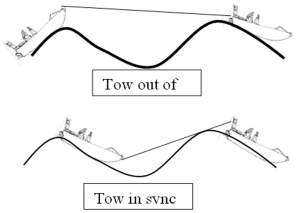
Bridal Configuration
This is used by vessels that have no Tow bits and have bridals made up on the bow of the Tow and at the stern of the Towing vessel. On Jet drives, it is possible to tow from the bow at marinas.
Towing with a set of bridals on the towing boat reduces the ability to steer as shown above. Steering can be done by slacking off the strain and turning and increase power repeatedly until on new heading.
If the Tow allows it there should be enough slack to have a catenary in the tow line. Make sure the tow is in synchronization with the tow boat, because if it is out of sync the tow boat could get swamped by dragging backwards through the swell.
Towing alongside
With the weather conditions in mind, this type of towing is used when putting the vessels tow alongside a wharf or floating dock at short distances in calm seas.
The first line to secure should be the for-spring, bow line, and then the stern brought in tight to towed vessels stern to make them tight. If the lines are to slack the vessel is harder to maintain a straight course and can cause the boats to surge more.
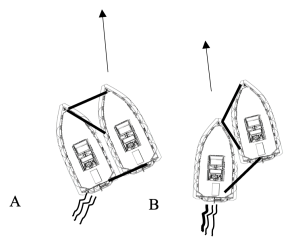
Bow Line
Stern Line- In this image, steer to port to take the slack from the stern line
Forward Spring Line.
Making the approach: When making the approach to tow consider the wind and drift of the boat to be towed.
- Towing vessel is Vessel A
- Vessel needing a tow is Vessel B
Side approach: When passing the tow alongside a crew member will throw the line to vessel “B” and vessel “A” will stop while tow is secured. A crew member should pass the towline, so it goes outside rails and passed to vessel requiring tow.
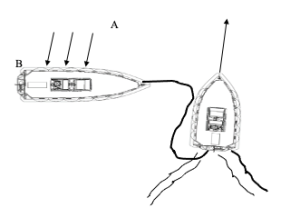
Towing Liferafts: The Towline should always be fixed to the towing patch on liferafts. Tow line should be of sufficient length so Exhaust fumes from FRB do not give occupants CO poisoning.

5.5 Pacing & Transfer
Reasons for pacing
There are several reasons for a FRB to Pace another vessel. The following are some examples of why this could take place:
- FRB to Survival Craft for transferring a casualty from a ship to another while at sea.
- Because of the ships rigging or non-opened deck to facilitate helicopter transfer. It may be required to launch FRB to pace with Helicopter.
- Launch and Recovery of an FRB
Hazards
Small craft have to be aware of the interactions of the ship, in the below diagram shows great dangers to small vessels moving through the bow wave (E) and (B) the vessels wake. These should always be avoided. As a vessel moves through the water, the displacement, speed and design of the vessel causes turbulence in the water around the hull. This is particularly noticed in larger vessels such as VLCC’s (Very large Crude Carriers).
The Illustration below shows the basic interaction of the sea with the hull of the ship while underway. The coxswain is responsible for the boat crew, if the approach looks to dangerous, ask for a better lee from the parent vessel if possible or try another attempt.

water.
A – Causes thrust to be pushed away from the vessel.
B – Causes the stern wake to roll forward.
C – Causes the water closest to the vessel to be dragged forward with the vessel, there may also be a pronounced suction which will pull your boat against the ships side, sometimes violently!
D – Causes a push of water as the vessel moves forward and a Bulbous bow will increase this effect.
E-Causes water to drag with the vessel’s stern.
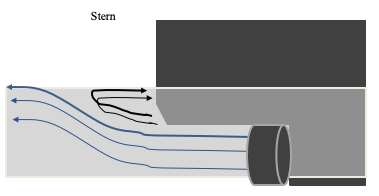
Always use one hand for the wheel and one for the throttle! The interactions between the vessel and the sea are extremely important, to understand for the Coxswain of the Lifeboat or FRB, to prepare for, or counteract the effects of this when going alongside. When maneuvering in position for a MOB situation or pacing, one hand should be on the wheel and one on the throttle for outboard or inboards. Jet drives are safer to have one hand on the wheel and one on the throttle for pacing and one hand on the wheel and the other on the bucket control for MOB for quick maneuvers astern and ahead.
It is very important for the coxswain to use small steering adjustments when going alongside and when the Lifeboat/ FRB gets alongside, leave 5-10°Rudder to hold it there. If too much rudder is used it will cause the Fast Rescue Boat to heel over away from ships side.
Another effect will be the suction from the vessel preventing you from getting away from ships side even when helm is turned outboard! If the RPM is lowered and increased by 10-20%, this will assist in the release of the suction and will make a water wedge between FRC and ship.
Approaching a Vessels Beam
The approach should always be made from the lee of the vessel, while on a steady course, and the Lifeboat/FRB, using slight angles with the helm!
- When Boat is alongside, keep 5-10°Rudder towards ship
- Pick up Painter (BOW LINE)
- And ease back on Painter to hook up falls.
- Crew members remain seated until FRB is at its embarkation level.
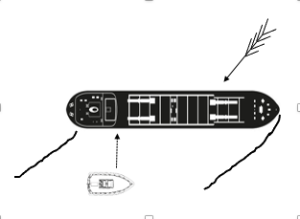
Image Credits
- Patley, G. (2021). Double sheet bend; but it’s fine?[blogpost]. Over The Edge Rescue. https://overtheedgerescue.com/rope rescue/double-sheet-bend/
